The Unfinished Obelisk: A Must-See for Any Egyptologist
The Unfinished Obelisk is an absolute must-see if you are an Egyptologist or fascinated by ancient civilizations. This granite monument abandoned thousands of years ago in the quarries of Aswan, is one of the most important archaeological finds in Egypt. Its unfinished state provides valuable insight into the stonemasonry methods of the ancient Egyptians.
Join me as we explore the mysteries surrounding the creation of these magnificent obelisks and discover the secrets of their construction. Whether you are a history buff or appreciate incredible ancient craftsmanship, the Unfinished Obelisk is an experience that should not be missed.
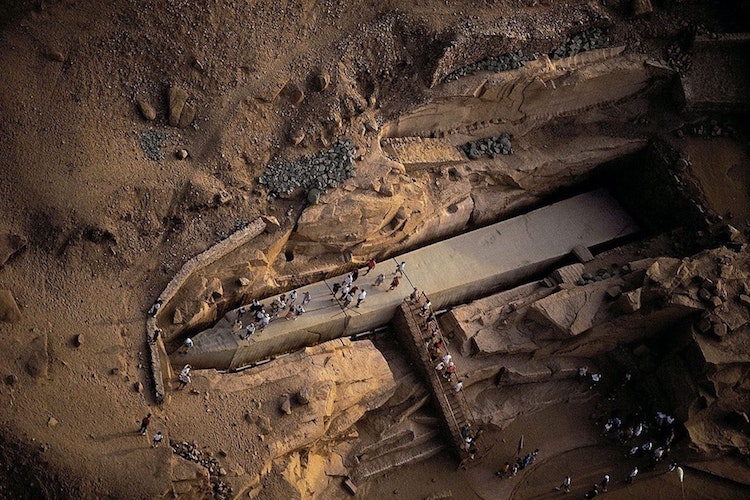
The Significance of the Unfinished Obelisk in Egyptology
The Unfinished Obelisk is an iconic archaeological site in Aswan, Egypt, with significant implications for Egyptology. This massive monolith provides valuable insights into ancient Egyptian stonemasonry techniques, construction methods, and obelisks' cultural and religious significance.
The obelisk was intended to be a towering structure, standing at a staggering height of approximately 42 meters (138 feet) and weighing around 1200 tons. However, due to a flaw in the granite bedrock, the obelisk was never completed and remained partially attached to the quarry. This flaw caused a crack to develop, leading to the project's abandonment.
Despite its incomplete state, the Unfinished Obelisk offers information about ancient Egypt's stone-carving techniques. Egyptologists can observe the intricate marks left by ancient workers, revealing the careful planning and precise craftsmanship employed to extract and shape the obelisk. Tools like copper chisels and wooden wedges were likely used to cut and shape the granite, leaving remarkable evidence of ancient stonemasonry.
In ancient Egyptian culture, obelisks held great religious and cultural significance. They were often placed in pairs at the entrances of temples, acting as symbolic representations of the sun god Ra. The Unfinished Obelisk's location near the ancient quarries at Aswan also highlights the importance of this site in the granite quarrying industry, which played a crucial role in ancient Egyptian architecture.
Today, visiting the Unfinished Obelisk gives Egyptologists and tourists an extraordinary opportunity to witness the magnitude and grandeur of ancient Egyptian architecture. The site is easily accessible in Aswan and is close to other notable attractions, such as the Temple of Philae and the Aswan High Dam. Planning a visit to the Unfinished Obelisk is necessary for anyone interested in Egyptology and ancient civilizations.
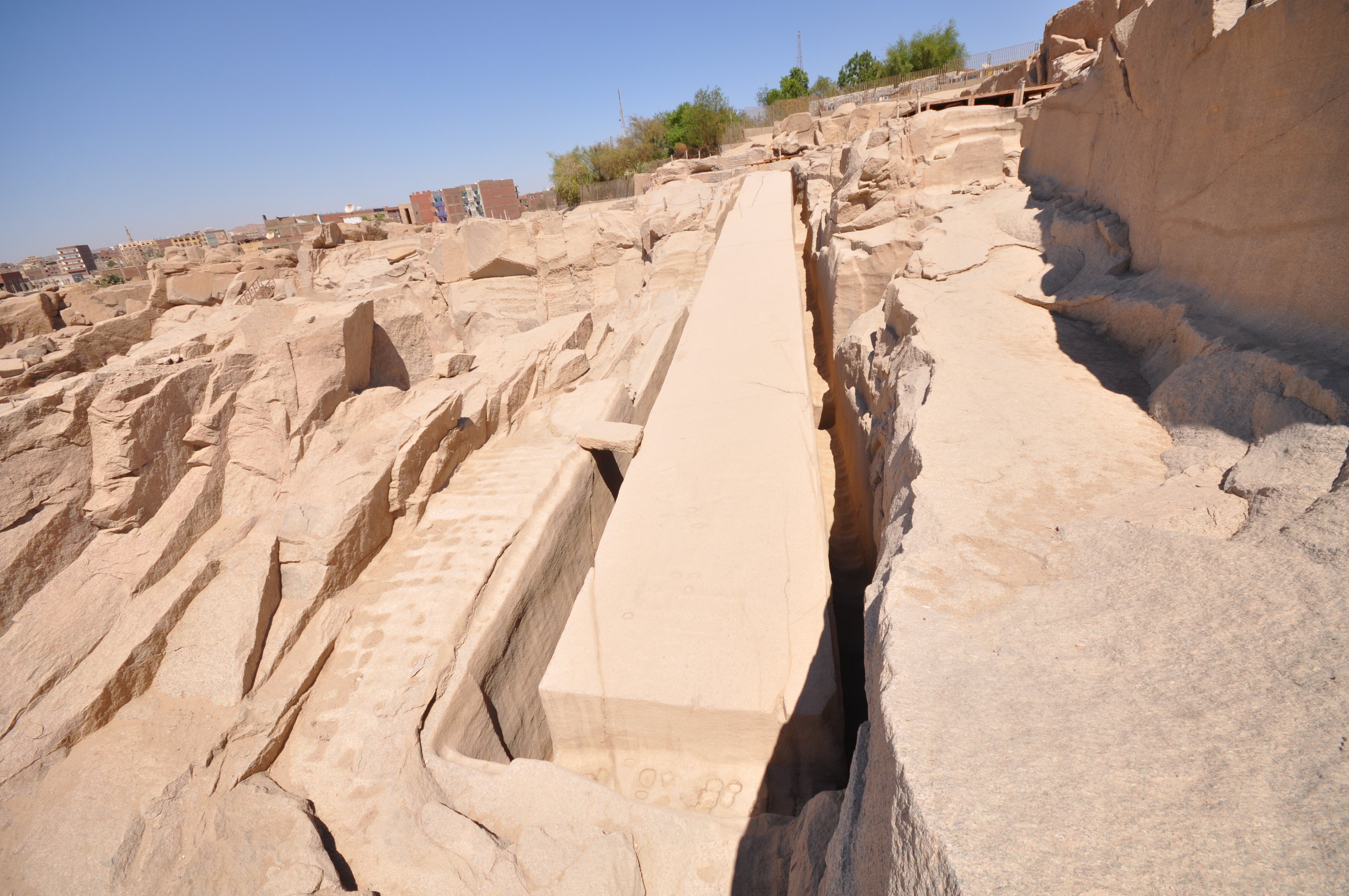
Importance of visiting the site for Egyptologists
Visiting the Unfinished Obelisk is of immense importance for Egyptologists and anyone interested in ancient Egyptian history. This massive monument provides invaluable insights into ancient Egyptians' construction techniques and methods in shaping their impressive structures.
One of the primary reasons for visiting the site is to understand the construction plans and purpose of the obelisk. By examining the obelisk up close, Egyptologists can gain a deeper understanding of the tools and techniques used by ancient stonemasons to carve these monolithic structures. The site offers a unique opportunity to witness firsthand the unfinished nature of the obelisk, providing valuable clues about its construction and the challenges faced during its creation.
The Unfinished Obelisk also sheds light on the materials and carving techniques used by ancient Egyptians. The obelisk was carved from solid granite, requiring careful planning and intricate workmanship. By studying the marks and unfinished carvings on the obelisk, Egyptologists can analyse the techniques employed by ancient stonemasons and gain insights into their artistic and engineering skills.
Moreover, the Unfinished Obelisk holds religious and cultural significance in ancient Egyptian society. Obelisks were considered sacred symbols and were often erected in temples or front of monumental structures. Understanding the cultural and religious beliefs associated with these structures helps Egyptologists unravel the mysteries of ancient Egyptian civilisation.
Visitors will also appreciate the convenient location and accessibility of the site in Aswan. Located near the famous Aswan Granite Quarries, where the ancient Egyptians sourced the granite for their monuments, the Unfinished Obelisk provides a unique opportunity to explore the surrounding area and gain a deeper appreciation for the scale of ancient Egyptian quarrying operations.
Overall, visiting the Unfinished Obelisk is a must for every Egyptologist, as it offers a rare chance to delve into the world of ancient Egyptian stonemasonry, gain knowledge about their construction methods, and unravel the secrets of their religious and cultural beliefs.

History of the Unfinished Obelisk
Construction Plans and Purpose of the Obelisk
The construction plans for the Unfinished Obelisk in Ancient Egypt were ambitious and impressive. The obelisk was intended to be one of the largest ever built, measuring around 41.75 metres (137 feet) in height and weighing an estimated 1,200 tonnes. The purpose of constructing such massive obelisks was to honour the pharaohs and the sun god Ra, as these towering monuments were believed to link the earthly and divine realms.
Ancient Egyptians selected a specific piece of granite from Aswan to create the obelisk, known for its high quality and durability. Skilled stonemasons meticulously carved away the excess rock to shape the obelisk using basic tools such as copper chisels, wooden mallets, and abrasive sand. They employed ‘pecking’ to mark the desired shape on the stone before gradually removing the excess material.
The construction process was meticulous and required great precision. However, the work on the Unfinished Obelisk was abruptly halted due to a structural flaw. A large crack appeared during the carving process, which was deemed impossible to continue. The obelisk was abandoned in the quarry, providing valuable insights into ancient stonemasonry methods and techniques.
Today, visiting the site of the Unfinished Obelisk in Aswan is a must for any Egyptologist or history enthusiast. It offers a unique opportunity to witness the colossal size and grandeur of these ancient monuments and gain a deeper understanding of the craftsmanship and engineering skills of the ancient Egyptians. Additionally, the site provides a fascinating glimpse into the construction process behind these impressive obelisks.

Reasons for abandonment and preservation of the site
The Unfinished Obelisk, located in Aswan, Egypt, is a fascinating archaeological site with significant value for Egyptologists. The obelisk was abandoned during its construction due to a flaw in the granite, which caused a crack to develop and render it unusable.
Despite its unfinished state, the obelisk provides valuable insights into ancient Egyptian stonemasonry techniques and offers a glimpse into the scale and precision of their monumental architecture. Preservation efforts have played a crucial role in maintaining the site's historical and educational significance. The obelisk remains in its original location, allowing visitors to witness the massive scale and intricacy of the carving process. The decision to leave it unfinished showcases the challenges faced by ancient stonemasons and the dedication required to create such monumental structures.
Preserving the Unfinished Obelisk also allows researchers and Egyptologists to study the ancient carving techniques and materials. The size and weight of the obelisk give valuable insights into the logistics involved in quarrying and transporting such enormous stones. Studying the obelisk provides a deeper understanding of the ancient Egyptian culture, religious beliefs, and their mastery of stonework.
Visiting the Unfinished Obelisk is a must for any Egyptologist or enthusiast. Located in the ancient granite quarries of Aswan, the site is easily accessible and offers a unique opportunity to witness an unfinished monument of ancient civilization. Additionally, exploring the nearby attractions, such as the Aswan High Dam and the Philae Temple, further enriches the Egyptological experience. Planning a visit to the Unfinished Obelisk as part of a broader itinerary is recommended to make the most of the trip to Aswan.

Insights into ancient stonemasonry methods
The Unfinished Obelisk provides valuable insights into the ancient stonemasonry methods employed by the ancient Egyptians. The obelisk was intended to be one of the largest in Egypt, standing at an estimated height of 42 meters (almost 138 feet) and weighing around 1,200 tons. The decision to carve such a massive structure from a single piece of stone emphasizes the ancient Egyptians' highly skilled craftsmanship and precision.
The ancient stonemasons used tools and techniques to carve the obelisk. They primarily used small hand tools made of harder stones, such as dolerite or granite, to shape and sculpt the obelisk. These tools included chisels, hammers, and hard stone pounders, essential for removing larger chunks of stone. The masons then use finer tools, such as copper chisels and wooden mallets, to refine the surface and achieve the desired shape and texture.
To create the intricate hieroglyphs and reliefs on the obelisk, the stonemasons used a technique called "bas relief," in which the design is carved slightly below the stone's surface. This method allowed for deeper and more detailed engraving while ensuring the stability and strength of the structure. The final touches involved polishing the obelisk to create a smooth and glossy finish.
The Unfinished Obelisk provides valuable evidence of the techniques and processes employed by ancient Egyptian stonemasons, offering a unique glimpse into their remarkable craftsmanship and skill. Visiting the site provides archaeologists, historians, and Egyptology enthusiasts the opportunity to witness firsthand the impressive feats of engineering and artistic abilities of the ancient Egyptians.
The Unfinished Obelisk: Key Facts and Features
Dimensions and weight of the obelisk
The Unfinished Obelisk, located in Aswan, Egypt, is a remarkable archaeological site that holds great significance in Egyptology. One of the most notable aspects of this monument is its monumental size. The obelisk measures approximately 42 meters (138 feet) in length and would have weighed an estimated 1,200 tons if it had been completed. To put this into perspective, that's roughly the weight of 200 elephants!
The dimensions and weight of the obelisk provide valuable insights into the sheer scale of ancient Egyptian construction projects and the advanced engineering techniques used by the ancient Egyptians. It is believed that the obelisk was intended to be erected at the nearby Temple of Karnak, making it one of the largest obelisks ever attempted in ancient Egypt.
Carving such a massive structure required precise stonemasonry techniques. The ancient Egyptians used a combination of pounding the rock with dolerite stone hammers and chiselling with finer tools made of copper or bronze. The Unfinished Obelisk offers a rare opportunity to witness the carving techniques and marks left by the ancient stonemasons, providing valuable knowledge about their craftsmanship.
Visiting the Unfinished Obelisk provides Egyptologists and enthusiasts with a unique opportunity to witness firsthand the impressive scale and craftsmanship of ancient Egyptian monuments. Exploring the site allows one to appreciate the dedication and skills of the ancient Egyptian stonemasons and gain a deeper understanding of ancient Egyptian culture and religious beliefs.
Planning a visit to the Unfinished Obelisk is relatively straightforward, as it is located in the heart of Aswan and easily accessible by various means of transportation. While there, visitors can also explore nearby attractions and sites such as the Aswan High Dam and Philae Temple, further deepening their understanding of ancient Egyptian history and civilization.
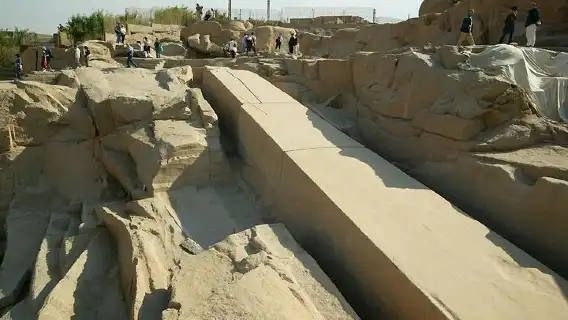
Carving techniques and materials used
Ancient Egyptians used a variety of techniques and materials to carve the Unfinished Obelisk, which provides valuable insights into their stonemasonry methods:
-
Tooling Techniques: The primary tool used to carve the obelisk was a hard stone pounder used to pound along the desired lines to create indentations. These indentations were then carefully chiselled to remove the excess stone. Bronze chisels and wedges were also used for precision carving and shaping.
-
Red Granite: The Unfinished Obelisk is made of red granite, a hard stone that the ancient Egyptians prized for its durability and aesthetic qualities. Red granite was quarried from the Aswan region, known for its high-quality deposits.
-
Advanced Quarrying Techniques: To extract the obelisk from the bedrock, the ancient Egyptians used "diagonal splitting." They would create a series of parallel channels along the sides of the obelisk using pounding and chiselling techniques. Wooden wedges were then inserted into these channels and soaked with water, causing the wedges to expand and split the stone.
-
Polishing and Finishing: After the initial shaping and carving, the obelisk would have been polished using abrasive materials such as sandstone and emery. The final step would involve smoothing the surfaces with finer abrasives to achieve a glossy finish.
The Unfinished Obelisk serves as a testament to the skill and ingenuity of ancient Egyptian stonemasons and offers valuable insights into their construction techniques and materials. A visit to the site provides a unique opportunity for Egyptologists and enthusiasts to witness firsthand the craftsmanship and artistry of this ancient civilization.
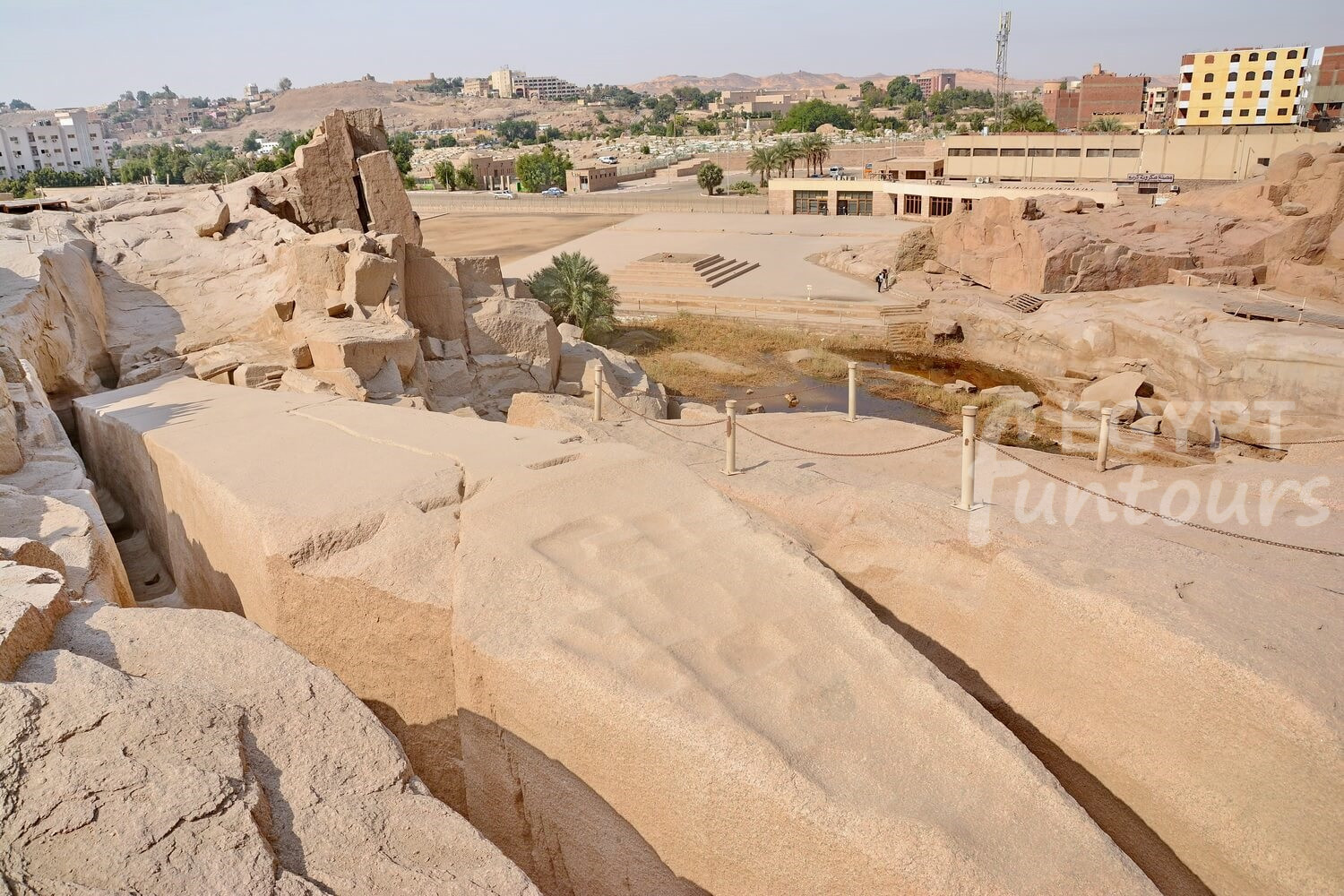
Significance of the Obelisk in Ancient Egyptian Culture and Religion
The Unfinished Obelisk holds great significance in ancient Egyptian culture and religion. Here are some key points:
- Symbol of Power and Divinity: Obelisks were sacred symbols in ancient Egypt, representing the connection between the earthly and divine realms. They were considered conduits of spiritual energy and were erected in temple complexes as monuments to the pharaoh's power and the gods.
- Ritualistic Importance: Obelisks played a crucial role in religious ceremonies and rituals. They were believed to harness and transmit cosmic energies, bringing blessings and protection to the surrounding area. They were frequently used as a focus for offerings and prayers.
- Alignment with the Sun: Obelisks were carefully aligned with astronomical events, particularly the sun's movement. The shadow cast by the obelisk would indicate the time of day and could be used as a solar calendar. The Unfinished Obelisk's location and orientation suggest that it was intended to serve as a marker of time and an instrument for pinpointing important celestial events.
- Architectural Excellence: The obelisk showcases the remarkable architectural skills of ancient Egyptian stonemasons. It provides valuable insights into their craftsmanship, tools, and techniques, revealing their mastery in carving massive stone structures.
- Cultural and Historical Significance: The Unfinished Obelisk is a tangible reminder of the ancient Egyptian civilization's grandeur and achievements. Its preservation allows us to appreciate the artistry and engineering prowess of the past while providing valuable information about their religious practices, social structure, and technological advancements.
Visiting the Unfinished Obelisk provides a unique opportunity to delve into the fascinating world of ancient Egypt and gain a deeper understanding of its cultural and religious significance. The site's historical and architectural value makes it a must-see for any Egyptologist or history enthusiast.

Visiting the Unfinished Obelisk
Location and accessibility of the site in Aswan
Located in Aswan in southern Egypt, the Unfinished Obelisk is a must-visit site for any Egyptologist or history enthusiast. Aswan is a popular tourist destination known for its rich historical and archaeological sites, and the Unfinished Obelisk is one of its most famous attractions.
With its central location on the eastern bank of the Nile River, the site is easily accessible by road, water, and air. Aswan has its international airport, making it convenient for visitors to fly directly to the city. From there, it's a short drive to the site of the Unfinished Obelisk.
Visitors can also reach Aswan by train, as the city is connected to major cities in Egypt, including Cairo and Luxor. Once in Aswan, transportation options such as taxis and local buses are readily available for visitors to the Unfinished Obelisk.
The accessibility of the site is further enhanced by its proximity to other popular attractions in Aswan. The famous Aswan High Dam and the Philae Temple complex are just a short distance away, making visiting multiple historical sites in one trip possible.
It's important to note that while the Unfinished Obelisk is open to visitors, some areas may be restricted for safety reasons. Visitors should always follow the instructions of the tour guides and abide by any safety regulations in place.
Overall, the location and accessibility of the Unfinished Obelisk in Aswan make it an ideal destination for anyone interested in ancient Egyptian history and culture. Visitors can immerse themselves in the fascinating world of Egyptology and gain a deeper understanding of the ancient stonemasonry techniques used to create these magnificent structures.
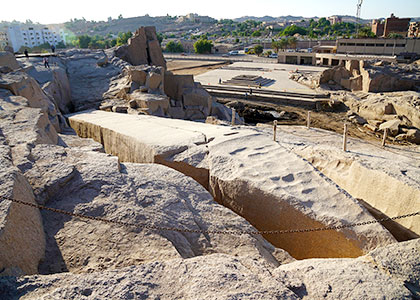
Nearby attractions and sites to explore
When visiting the Unfinished Obelisk in Aswan, Egypt, there are several nearby attractions and sites that Egyptologists and history enthusiasts should explore. These include:
-
Philae Temple: Located on an island in the Nile River, Philae Temple is a stunning example of ancient Egyptian architecture. Dedicated to the goddess Isis, the temple offers a glimpse into the religious practices of the time.
-
Aswan High Dam: A modern engineering marvel, the Aswan High Dam plays a significant role in controlling the Nile River's flow and preventing flooding. Visitors can learn about the dam's construction and its regional impact.
-
Nubian Museum: Situated on the banks of the Nile, the Nubian Museum showcases the rich culture and history of the Nubian people. It features exhibits on ancient artefacts, traditional crafts, and Nubian customs.
-
Elephantine Island: This small island in the Nile River is home to archaeological sites dating back to ancient times. Visitors can explore ruins, visit the Aswan Museum, and enjoy the island's scenic beauty.
-
Aga Khan Mausoleum: Built-in memory of Aga Khan III, the leader of the Ismaili Muslim community, the mausoleum is an architectural masterpiece. It offers a serene and picturesque setting overlooking the Nile.
-
Aswan Botanical Garden: Located on Kitchener's Island, this lush garden is a relaxing oasis amid the desert. Visitors can stroll through the beautifully landscaped gardens and admire the diverse plant species.
-
Tombs of the Nobles: Situated on the west bank of the Nile, the Tombs of the Nobles are a collection of rock-cut tombs dating back to the 6th dynasty. These well-preserved tombs provide insights into the lives of ancient Egyptian nobility.
When planning a visit to the Unfinished Obelisk, it is recommended to allocate time to explore these nearby attractions to appreciate the rich history and cultural heritage of Aswan fully.

Tips for planning a visit to the Unfinished Obelisk
Planning a visit to the Unfinished Obelisk in Aswan
Visiting the Unfinished Obelisk in Aswan is a unique opportunity for Egyptologists and history enthusiasts. Here are some tips to help you plan your visit:
-
Opening hours and tickets: The site is open to visitors daily from 7:00 am to 4:00 pm. Entrance tickets can be purchased at the gate, and it is recommended to arrive early to avoid crowds.
-
Guided tours: Hiring a local guide or joining a guided tour can enhance your visit by providing in-depth knowledge about the obelisk and its historical context.
-
Footwear and clothing: As the site consists of uneven terrain, it is advisable to wear comfortable shoes, such as sturdy walking shoes or sneakers, to explore the area safely. Additionally, it is recommended to dress modestly and wear appropriate sun protection, as the site is exposed to the sun.
-
Photography: Cameras and photography are allowed at the site, so don't forget to bring your camera or smartphone to capture the fascinating ancient structures and surroundings. However, drone photography is not permitted.
-
Hydration and snacks: As the site can be hot and exhausting, bringing a bottle of water is advisable to stay hydrated. Additionally, packing some snacks or sandwiches can ensure you have something to eat during your visit.
-
Accessibility: The Unfinished Obelisk site is accessible for most visitors but may not be suitable for individuals with mobility issues due to uneven surfaces and steps. However, there are benches and shaded areas available for rest.
-
Combine with other attractions: While in Aswan, consider exploring other nearby attractions, such as the Philae Temple, the High Dam, and the Nubian Museum, to make the most of your visit.
Remember to respect the site and follow any guidelines or instructions the authorities provide. Happy exploring!
